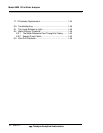
Part III: 1-1
Oil in Water Part III
Teledyne Analytical Instruments
1.0 Introduction
The Teledyne Oil-in-Water Analyzer utilizes the ultraviolet (UV) absorp-
tion principle to detect and continuously measure oil concentration in water. The
analyzer consists of two integrated systems: (1) a single external sample cell,
chopped beam, dual-wavelength UV process photometer and associated con-
trol analysis unit and electronics, and (2) a sample system that delivers to the
photometer a sample which represents the true oil content of the stream being
analyzed, or a “zero” fluid of oil-free sample delivered to the photometer at a
preset interval once each hour. This oil-free sample is used to reset the zero
reference point on the recorder.
NOTE: Previously, to differentiate between oil and other organic compounds,
oil was formally defined as any material in the sample stream that could be
extracted by carbon tetrachloride, chloroform, hexane, or petroleum ether.
We now know, however, that our oil in water analysis system correlates
exceptionally well to EPA and marine testing methods based upon a more
realistic definition pertinent to how our system works. That is, the definition
of what is truly oil in water from fossil fuel sources is what can be coarse
filtered (non-dissolved oils) and what can be ultra fine filtered (dissolved oils)
from the process water sample. The above definition is a result of a one year
continuous field evaluation by the EPA during the early 80’s which specified
that the Teledyne oil in water system showed good correlation with results
obtained by EPA method 413.1 (superceded in February 1999, by method
1664A using hexane). The field tests were conducted at primary and
secondary effluent sampling points at a refinery. The investigation determined
calibration curves for process oil versus EPA reference oils and validation of
the calibration and sample measurement process against EPA method 413.1
“oil and grease total recoverable.” The report and evaluation was conducted
by the Environmental monitoring and support laboratory, at EPA Cincinnati,
Ohio. The Teledyne Oil-in-Water Analyzer is designed to operate effectively
within the parameters established by this newer accepted definition of oil.


















